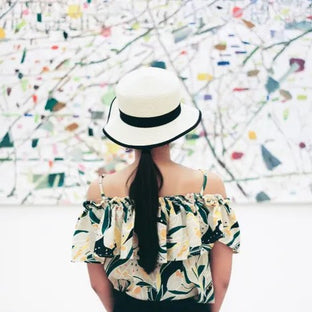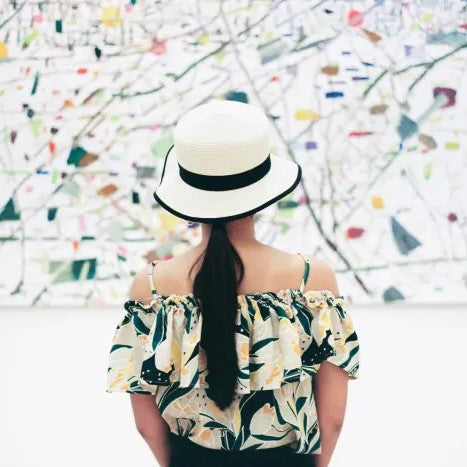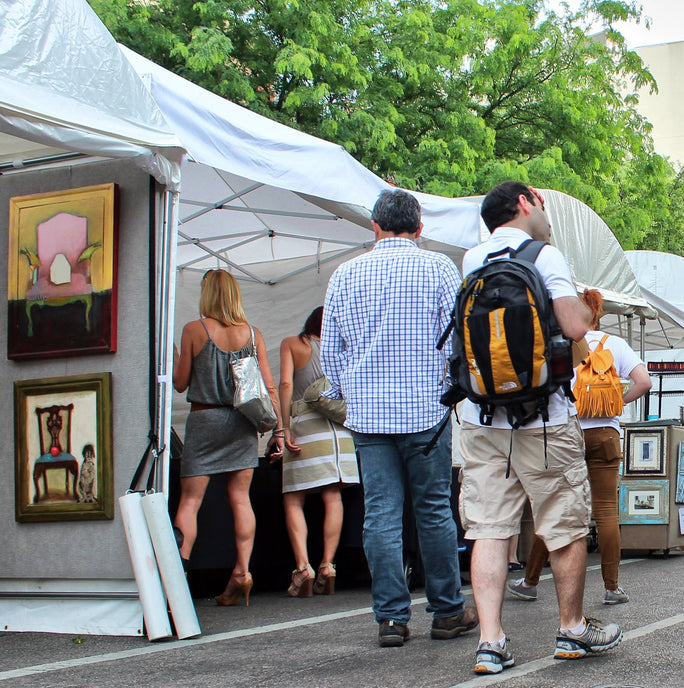How to Look at Art: 7 Helpful Tips



“It's not what you look at that matters, it's what you see.”
Henry David Thoreau
Most of us have that one friend who seems a bit vexed by the experience of viewing art, and furrows their brow at the mention of a visit to an art gallery or museum. Maybe you yourself are “that guy,” the one who reluctantly visits the museum because a family member persuades you to come along.
It seems intuitive that we would know how to “look at art,” at least in the literal sense. The fact that this requires a “how to” list might be perplexing to some. The reality is that many people avoid art immersion out of fear that they may be “doing it wrong.” They assume art appreciation requires a sophisticated eye or a minor degree in Fine Art or Art History. While that isn’t actually the case, we offer a few tips for art newbies and the unaccustomed which should add value and greater enjoyment to the experience.
Tips for the Uninitiated for Viewing (and Enjoying!) Art
1. Gain a Basic Understanding
While it isn’t necessary to enroll in Art History 101 at your local university or buy an extensive catalog of books about van Gogh and Michelangelo, spend a little time reviewing easily accessible information relating to the fundamentals of art which will help you to understand and appreciate it.
The internet offers a wealth of art education including articles, access to online galleries and academic publications to explore in order to learn the basics. Some websites even provide useful exercises to test your analytical skills as it relates to understanding artworks. Utilize these resources while ensuring that you are seeking out credible sites which offer substantive information.
This is your opportunity to gain an understanding of the different mediums, canvases and styles of art, including paintings, sculptures, portraits and the list goes on. Learn the lingo and be able to differentiate between oils and acrylics, or modern as opposed to contemporary art. Research some of the more famous artists through history, and learn how their influence impacts current-day art and artists.
2. Identify Your Aesthetic Preferences
In contrast to the academic elements of witnessing great artworks, let yourself enjoy the experience by recognizing what speaks to you in the visual and emotional sense. Connecting with art doesn’t have to be a purely intellectual undertaking, but should also fuel the senses.
Making an emotional connection can mean being wowed by a breathtaking painting of a landscape or invigorated by the vibrant hues and often witty nature of pop art. It may involve feeling stirred by an artwork reflecting cultural or political relevance which causes us to rethink our perspective.
From modern to classical to abstract, there are many different styles of art, and if one doesn’t jar your senses, simply keep searching. If you remain unsure about what speaks to your artistic interests, we offer some additional helpful tips to explore and discover your preferences.
3. Get Up Close and Personal
Whether it is an in-person trip to a museum, a virtual tour, or a visit to an online art gallery, art is more accessible than ever. In fact, there is a wealth of opportunity available at our fingertips through online exhibits and virtual galleries.
Many museums and cultural centers have recently opened their exhibits to the virtual universe. Check out some of the most famous museums and art hubs in the world from the comfort of your own home, taking the time to immerse yourself and then reflect upon the experience.
Additionally, many art galleries have shifted from the traditional storefront to e-commerce platforms, making window shopping easier than ever. ARTnews predicts the online art market will only continue to grow, enhancing your ability not only to view, but also to purchase artwork.
4. Maintain an Open Mind
For many artists, the opportunity to make you think and consider a subject more deeply is a fundamental motivation for why they create. You may find some pieces even provoke a sense of personal discomfort.
According to the Washington Post’s take on being a spectator to art, if you don’t occasionally leave the museum or gallery with a sense of uneasiness, you may not be doing it right. Allow the experience of this artwork to make you question and feel and perhaps even reconsider what you otherwise believe to be true.
5. Find Meaning
For most artists, their work is a form of expression. Art is their mechanism to tell a story or convey a compelling message which may be personally meaningful
With this in mind, examine the art closely to determine what you think the artist is trying to share with you, the viewer. Take notes and test your interpretation by comparing it to what the artist has documented as their inspiration and intention for the work.
Determining the style of the art goes a long way toward interpreting its meaning as well. For example, if the art is a realist painting, the meaning may be more straightforward. Abstract or surrealist art may require a more deliberate and deeply analytical approach.
6. Get to “know” the Artists
Art is often a reflection of the artist’s background and experience which can include their culture, history, spirituality, struggles and joy.
If a work speaks to you, seek out and read the artist’s biography to learn more about what inspires them. This helps us to interpret and find meaning within each individual piece. After all, who knows the meaning of their art better than the artist?
7. Be Serious, but Not Too Serious
We’ve outlined the ways in which we should take viewing art more seriously, but ultimately art is to be enjoyed and appreciated. With a few of these tools in your arsenal, you can be a knowledgeable patron of art while still finding pleasure in the experience.





